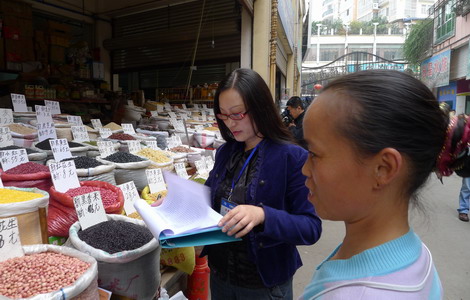Price collector gives us food for thought
Updated: 2011-11-09 09:29
By Chen Jia (China Daily)
|
|||||||||||
|
How much for those? And these? The prices Chen Li collects at a Sichuan market, and those reported by her counterparts nationwide, will contribute to the calculation of China's consumer price index. [Photo / China Daily] |
Chen Li arrived at the market at 9 in the morning, the designated hour, to inquire about food prices. Pork, on that particular day, Oct 20, was 29 yuan ($4.56) a kilogram, butcher Sun Xun told Chen. It was the same price recorded in Chen's tally book on Oct 15, which, in turn, was 1 yuan lower than on Oct 10.
Chen, 45, works in the consumer price office, in Mianyang, Sichuan province, for the National Bureau of Statistics.
The prices she monitors are the statistics the bureau uses to calculate the monthly consumer price index (CPI), a main gauge of inflation. Once this is calculated the information is flashed around the world to be digested by the financial markets.
The bureau opened consumer price offices in 31 provinces, covering 500 cities and counties, in 1984. Provincial-level offices report the collected price data to headquarters in Beijing. About 4,000 monitors now gather the data.
Every five days, Chen goes to the same markets and records food prices during the same hour, between 9 and 10 am. "For each variety of food, I need to collect prices from three different sellers," Chen said.
To make sure the sample prices are as close as possible to real market prices, only the after-bargaining trading prices can be written down, according to bureau requirements. Chen said that very often, she must buy the food to know the exact prices.
"At first," Sun said, "I didn't like to tell Chen the meat prices when I saw her writing numbers down in her notebook. I thought she was a spy working for other butchers. But after she told me that the inquiring is for CPI calculation I like to give her the true prices."
He appreciated that the survey "has no influence on my business" and, as bureau staff had explained to him, that his information contributes to the country's macroeconomic policymaking.
High-tech help
The consumer price survey in Mianyang covers 126 markets and shops and 791 kinds of products and services. For food, 25 kinds of vegetables, eight kinds of fruit and 23 kinds of meat and egg are chosen as samples, said Yang Bin, director of the Mianyang survey office.
"We report the collected prices to the Sichuan provincial office on the 25th of each month," along with a report analyzing the reasons for price fluctuations, Yang said. "The headquarters usually directly calls some shops randomly and rechecks the original data."
Guan Jun, Chen's colleague, said that no matter how bad the weather or whether it's a holiday, the survey staff members go out to ask prices on specific dates - even after the 2008 Sichuan earthquake, when there was the danger of buildings collapsing. "It is worthwhile to do this, because we have the duty to ensure that the data are true," Guan said.
In 2010, the bureau initiated a digital data collection and management system. Using a handheld apparatus that resembles a mobile phone, staff members can input prices and upload the data directly. The system also has a GPS function that can show where the collectors are and, thus, where the prices come from.
Bureau commissioner Ma Jiantang said the bureau is trying to send the new tool to every price collector by the end of 2011. "With the help of high tech, it can reduce the heavy burden on the grassroots staff and improve the accuracy of the data," he said.
Decrease expected
In July, the bureau began releasing its CPI report on the ninth of the month, instead of the 11th, to prevent information leaks. The bureau receives data from the provincial statistical offices on the sixth of the month. CPI figures are published on the bureau's website within 24 hours after calculations are completed.
The September consumer price index, which was published on Oct 9, showed that China's inflation was on track to decline after it hit a three-year high of 6.5 percent in July. The CPI came in at 6.1 percent higher than the rate in September 2010; the August rate was 6.2 percent. October's CPI is due out Wednesday.
Stabilized pork prices have moderated food prices, which account for almost 30 percent of products in the CPI basket. And figures in the last quarter of this year are expected to continue to fall, thanks to lower prices for raw production materials and the prices of imported goods, said Wang Tao, an economist with UBS Securities.
The inflation gauge is one of the most important reference points for authorities to adjust economic policy, Wang said. If it continues to drop as she expects, China's tight monetary policy might be loosened in the first quarter of 2012, injecting liquidity to support infrastructure construction and boost economic growth.
A big basket
"I feel that inflation in my real life may be higher than the CPI," said Wei Ling, 27, who is a project manager assistant for a Japanese company in Beijing. "Clothing prices have almost doubled this year. Also, the rent keeps climbing every month, and I now have to pay about 20 percent more than that in January."
Pang Xiaolin, director-general of the bureau's Department of Urban Surveys, said the CPI is a comprehensive index that indicates the nationwide, year-on-year rate of change in consumer prices. "For individuals, because each person has special components in the consumption basket, the personal feeling could be far from the whole picture.
"Not all the consumer goods and services have been covered in the CPI basket," Pang said. "We choose the most popular products in people's daily consumption based on a sample survey of 140,000 urban and rural families, and the selected products can be changed according to seasonal or social influential factors."
China puts 262 basic categories of products and services in its CPI basket. The United States has 211, Canada 169 and Australia 87.









